Related Research Articles

Human cannibalism is the act or practice of humans eating the flesh or internal organs of other human beings. A person who practices cannibalism is called a cannibal. The meaning of "cannibalism" has been extended into zoology to describe animals consuming parts of individuals of the same species as food.

A prisoner of war (POW) is a person who is held captive by a belligerent power during or immediately after an armed conflict. The earliest recorded usage of the phrase "prisoner of war" dates back to 1610.

The Battle of Iwo Jima was a major battle in which the United States Marine Corps (USMC) and United States Navy (USN) landed on and eventually captured the island of Iwo Jima from the Imperial Japanese Army (IJA) during World War II. The American invasion, designated Operation Detachment, had the purpose of capturing the island with its two airfields: South Field and Central Field.

The Bonin Islands, also known as the Ogasawara Islands (小笠原諸島), is a Japanese archipelago of over 30 subtropical and tropical islands located around 1,000 kilometers (620 mi) SSE of Tokyo and 1,600 kilometers (1,000 mi) northwest of Guam. The group as a whole has a total area of 84 square kilometers (32 sq mi) but only two of the islands are permanently inhabited, Chichijima and Hahajima. Together, their population was 2,560 as of 2021. Administratively, Tokyo's Ogasawara Subprefecture also includes the settlements on the Volcano Islands and the Self-Defense Force post on Iwo Jima. The seat of government is Chichijima.
The Commando Order was issued by the OKW, the high command of the German Armed Forces, on 18 October 1942. This order stated that all Allied commandos captured in Europe and Africa should be summarily executed without trial, even if in proper uniforms or if they attempted to surrender. Any commando or small group of commandos or a similar unit, agents, and saboteurs not in proper uniforms who fell into the hands of the German forces by some means other than direct combat, were to be handed over immediately to the Sicherheitsdienst for immediate execution.

USS San Jacinto (CVL-30) of the United States Navy was an Independence-class light aircraft carrier that served during World War II. She was named for the Battle of San Jacinto during the Texas Revolution. Future U.S. President George H. W. Bush served aboard the ship during World War II.
The Biscari massacre was a war crime committed by members of the United States Army during World War II. It refers to two incidents in which U.S. soldiers were involved in killing 71 unarmed Italian and 2 German prisoners-of-war at the Regia Aeronautica's 504 air base in Santo Pietro, a small village near Caltagirone, southern Sicily, Italy on 14 July 1943.

The Kempeitai was the military police of the Imperial Japanese Army. The organization also shared civilian secret police, espionage, and counter-intelligence roles within Japan and its occupied territories, and was notorious for its brutality and role in suppressing dissent. The broad duties of the Kempeitai included maintaining military discipline, enforcing conscription laws, protecting vital military zones, and investigating crimes among soldiers. In occupied areas, it also issued travel permits, recruited labor, arrested resistance, requisitioned food and supplies, spread propaganda, and suppressed anti-Japanese sentiment. At its peak at the end of World War II, the Kempeitai was an extensive corps with about 35,000 personnel.

Chichijima (父島) is the largest and most populous island in the Bonin or Ogasawara Islands. Chichijima is about 240 km (150 mi) north of Iwo Jima. 23.5 km2 (9.1 sq mi) in size, the island is home to about 2,120 people (2021). Connected to the mainland only by a day-long ferry that runs a few times a month, the island is nonetheless organized administratively as the seat of Ogasawara Village in the coterminous Ogasawara Subprefecture of the Tokyo Metropolitan Government. Together with the Volcano and Izu Islands, it makes up Japan's Nanpō Islands.
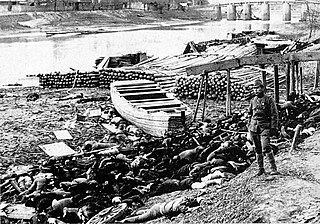
During its imperial era, the Empire of Japan committed numerous war crimes and crimes against humanity across various Asian-Pacific nations, notably during the Second Sino-Japanese and Pacific Wars. These incidents have been referred to as “the Asian Holocaust”. The majority of these crimes occurred during the early part of the Shōwa era, under Hirohito’s reign.
Nobuaki "Warren" Iwatake was an American citizen who was drafted by the Imperial Japanese Army to serve as a radio operator and communications intercepter.

James Bradley is an American author from Antigo, Wisconsin, specializing in historical nonfiction chronicling the Pacific theatre of World War II. His father, John Bradley, was involved in the first raising of the American flag on Mount Suribachi during the Battle of Iwo Jima in 1945.
During World War II, the Allies committed legally proven war crimes and violations of the laws of war against either civilians or military personnel of the Axis powers. At the end of World War II, many trials of Axis war criminals took place, most famously the Nuremberg Trials and Tokyo Trials. In Europe, these tribunals were set up under the authority of the London Charter, which only considered allegations of war crimes committed by people who acted in the interests of the Axis powers. Some war crimes involving Allied personnel were investigated by the Allied powers and led in some instances to courts-martial. Some incidents alleged by historians to have been crimes under the law of war in operation at the time were, for a variety of reasons, not investigated by the Allied powers during the war, or were investigated but not prosecuted.
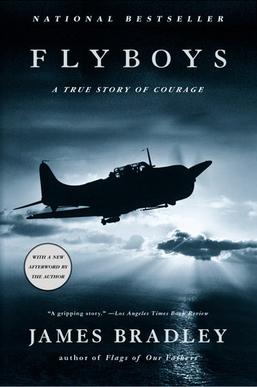
Flyboys: A True Story of Courage is a 2003 nonfiction book by writer James Bradley, and was a national bestseller in the US. The book details a World War II incident of the execution and cannibalism of five of eight American POWs on the Pacific island of Chichi-jima, one of the Ogasawara Islands. This event is now known as the Chichijima incident.
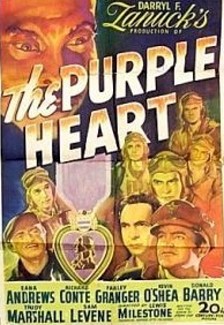
The Purple Heart is a 1944 American war film, produced by Darryl F. Zanuck, directed by Lewis Milestone, and starring Dana Andrews, Richard Conte, Don "Red" Barry, Sam Levene and Trudy Marshall. Eighteen-year-old Farley Granger had a supporting role.

The Selarang Barracks incident, also known as the Barrack Square incident or the Selarang Square Squeeze, was a revolt of British and Australian prisoners-of-war (POWs) interned in a Japanese camp in Changi, Singapore.
The 109th Division was an infantry division of the Imperial Japanese Army. Its call sign was the Courage Division. It was formed on 24 August 1937 in Kanazawa as a square division, simultaneously with the 108th division. The nucleus for the formation was the 9th division headquarters. It was subordinated from the beginning to the Japanese Northern China Area Army.
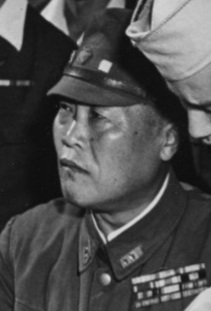
Yoshio Tachibana was a lieutenant general in the Japanese Imperial Army during World War II. He was commander of the Japanese garrison in Chichijima, Ogasawara Islands, and was later tried and executed for the Chichijima incident, a war crime involving torture, extrajudicial execution and cannibalism of American prisoners of war.
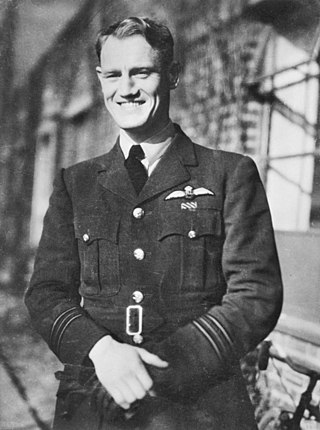
Phillip John Lamason, was a pilot in the Royal New Zealand Air Force (RNZAF) during the Second World War, who rose to prominence as the senior officer in charge of 168 Allied airmen taken to Buchenwald concentration camp, Germany, in August 1944. Raised in Napier, he joined the RNZAF in September 1940, and by April 1942 was a pilot officer serving with the Royal Air Force in Europe. On 8 June 1944, Lamason was in command of a Lancaster heavy bomber that was shot down during a raid on railway marshalling yards near Paris. Bailing out, he was picked up by members of the French Resistance and hidden at various locations for seven weeks. While attempting to reach Spain along the Comet line, Lamason was betrayed by a double agent within the Resistance and seized by the Gestapo.

The Palawan massacre occurred on 14 December 1944, during World War II, near the city of Puerto Princesa in the Philippine province of Palawan. Allied soldiers, imprisoned near the city, were killed by Imperial Japanese soldiers. Only eleven men managed to survive.
References
- ↑ Laurence, Charles (October 26, 2003). "George Bush's comrades eaten by their Japanese PoW guards". The Telegraph . Retrieved November 15, 2014.
- ↑ Felton, Mark (2010). The Final Betrayal: Mountbatten, MacArthur and the Tragedy of Japanese POWs. Pen & Sword Military. ISBN 978-1-84884-094-2.
- ↑ "Torture, cannibalism and submarine rescues: George HW Bush's extraordinary WWII survival story". www.9news.com.au.
- ↑ Iserson, Kenneth V. (2001). Death to Dust: What Happens to Dead Bodies?. Galen Press. ISBN 978-1-883620-22-6.
- 1 2 Case No. 21 Trial Of General Tomoyuki Yamashita[,] United States Military Commission, Manila, (8 October–7 December 1945), and the Supreme Court Of The United States (Judgments Delivered On 4 February 1946). Part VI. Archived from the original on December 8, 2006. Retrieved December 18, 2006.
- 1 2 Welch, JM (April 2002). "Without a Hangman, Without a Rope: Navy War Crimes Trials After World War II" (PDF). International Journal of Naval History. 1 (1). §Cannibalism. Archived from the original (PDF) on June 14, 2007. Retrieved December 3, 2007.
- ↑ "The Pacific War Online encyclopedia: Mori Kunizo". pwencycl.kgbudge.com. Retrieved August 18, 2021.
- ↑ Bradley, James (2003). Flyboys: A True Story of Courage (1st ed.). Little, Brown and Company. ISBN 0-316-10584-8.
- ↑ Bradley, James (2004) [2003]. Flyboys: A True Story of Courage (1st ed.). Boston: Back Bay Books. pp. 229–230, 311, 404. ISBN 0-316-15943-3 . Retrieved December 26, 2007.